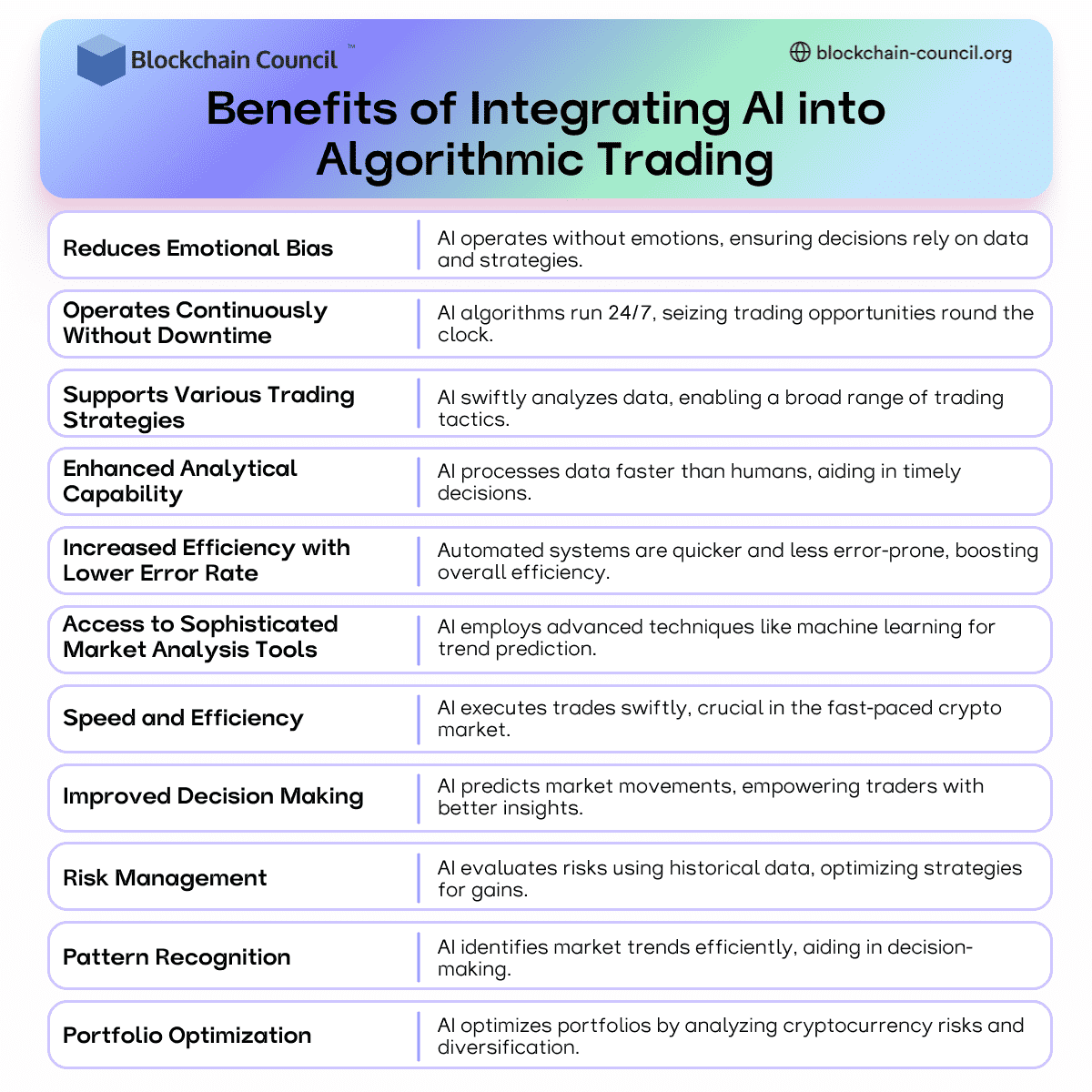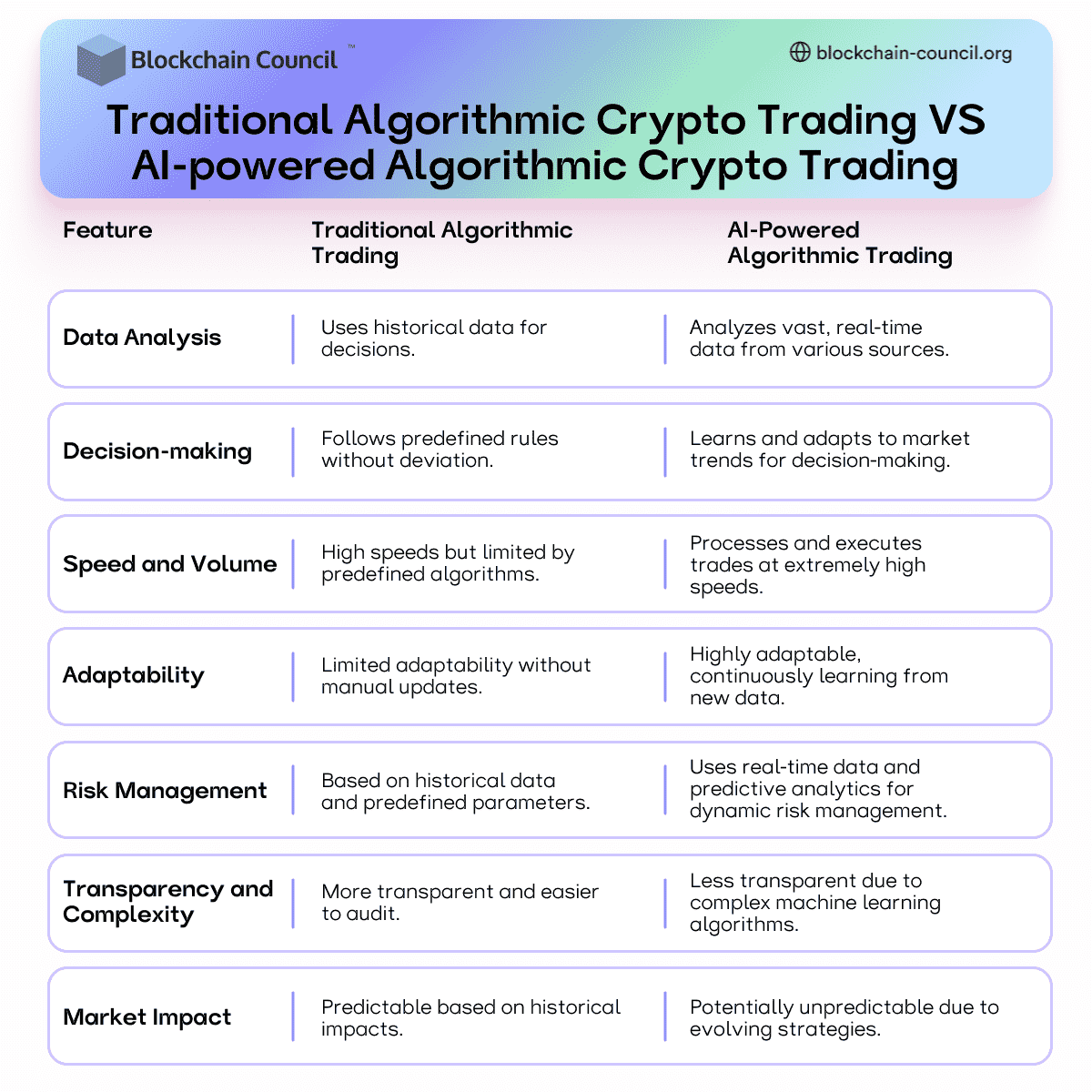
- Blockchain Council
- January 09, 2025
Summary
- AI is changing algorithmic crypto trading by making it more efficient and accurate.
- Algorithmic trading in crypto uses automated software to make trades based on specific rules.
- AI reduces emotions in trading and works non-stop, supporting various trading strategies.
- It helps predict market trends better, making strategies like trend-following more effective.
- AI also improves algorithmic crypto trading strategies like mean reversion, arbitrage, news-based, and pair trading.
- But there are risks, like AI algorithms being too complex to understand or overfitting.
- To manage risks, traders need to use multiple data sources and test their systems carefully.
- AI-powered trading is different from traditional trading in terms of decision-making and adaptability.
- Despite the challenges, AI is expected to continue shaping the future of crypto trading.
- Traders must stay informed about AI technology and be aware of its risks.
In the fast-paced world of cryptocurrency trading, artificial intelligence (AI) is transforming the game. Algorithmic trading has been popular for a while. However, with the integration of AI, these strategies have become more efficient, more accurate, and far more dynamic.
In this article we will understand the role of AI in algorithmic crypto trading. We will dive into the specifics of how AI is changing the landscape of algorithmic crypto trading by offering insights into its ability to predict market movements, manage risks, and increase profitability in ways that were hard to imagine just a few years ago.
What is Algorithmic Trading in Crypto?
Algorithmic trading or algo trading in the cryptocurrency market is a process that uses automated software to execute trades based on predefined criteria set by a user. These criteria might include, but are not limited to, price, timing, and volume.
It involves using computer programs to execute trades based on predefined criteria and mathematical algorithms. This approach is highly effective in the crypto market, which is known for its high volatility and 24/7 operations.
Traders use algorithmic trading for various strategies such as arbitrage, market making, and short-term trading. It aims to remove emotional decision-making and helps traders stick to their strategies, potentially leading to more profitable outcomes.
Also Read: What is Bitcoin Cloud Mining?
Benefits of Integrating AI into Algorithmic Trading
How AI Can Enhance Algorithmic Crypto Trading Strategies
AI can significantly improve various algorithmic crypto trading strategies, making them more efficient, accurate, and profitable. Here’s a breakdown of some common strategies and how AI enhances them:
Trend-following
Trend-following strategies involve identifying and riding the momentum of market trends. AI enhances this strategy by using advanced analysis techniques like machine learning algorithms to predict trend directions and strengths more accurately. It can process vast amounts of historical and real-time data, identify subtle patterns not evident to human traders, and make predictions about future market movements. This helps traders to enter and exit trades at optimal times, increasing profitability.
Mean Reversion
This strategy is based on the theory that prices and returns eventually move back toward the mean or average. AI can analyze historical price data to identify the mean price levels and predict when the market is likely to revert to these levels. By processing large datasets quickly and accurately, AI can spot mean reversion opportunities faster than manual methods, enabling traders to make quicker, more informed decisions.
Arbitrage
Arbitrage involves exploiting price differences of the same asset across different markets. AI can monitor multiple markets in real-time, detect arbitrage opportunities instantly, and execute trades rapidly to capitalize on these opportunities before they disappear. AI’s ability to process and analyze data from multiple sources simultaneously makes it invaluable for arbitrage strategies, ensuring traders can maximize their gains from price discrepancies across exchanges.
News-based Trading
AI algorithms can scan, interpret, and analyze news articles, social media posts, and other textual data in real-time to gauge market sentiment and predict its impact on asset prices. This allows for automated trading based on news events, helping traders to leverage market movements triggered by news releases more efficiently than ever before. AI’s natural language processing capabilities enable it to understand the context and relevance of news items, making it possible to act on information faster than humanly possible.
Pair Trading
Pair trading involves taking matching positions in two correlated securities when their price relationship deviates from their historical average. AI can monitor the price relationship between pairs, identify deviations, and execute trades automatically when opportunities arise. Machine learning models can also predict future price movements based on historical data, improving the timing of entry and exit points for pair trades.
Also Read: How to Improve Crypto Trading Strategies with AI?
Challenges and Risks in AI-Powered Algorithmic Trading
The transition from traditional algorithmic trading to AI-powered trading systems introduces several challenges and risks.
- One significant concern is the “black box” risk, where AI algorithms are so complex that their decision-making processes are difficult to understand, even for their creators. This lack of transparency makes it challenging to identify and correct biases or errors in the algorithms, potentially leading to poor decision-making.
- Furthermore, there’s the risk of overfitting, where an AI algorithm trained on a limited data set fails to generalize to new, unseen scenarios, leading to inaccurate predictions.
- Model risk, referring to flaws within the AI model itself, can also lead to incorrect decisions if the underlying code, assumptions, or data are inaccurate.
- Data security and privacy are additional concerns, as AI systems, like all technological solutions, are susceptible to cyberattacks, which could compromise the integrity of the financial system and the privacy of individual data.
To mitigate these risks, it’s essential to utilize multiple data sources to reduce overfitting and ensure models are accurate and robust. Testing systems with historical data and simulation can help identify any biases or errors in the model.
Employing statistical methods like Monte Carlo simulation, Bayesian inference, and Markov chain Monte Carlo can measure uncertainty in AI systems, providing a clearer picture of the range of possible outcomes.
Traditional Algorithmic Crypto Trading VS AI-powered Algorithmic Crypto Trading
Conclusion
The role of AI in algorithmic crypto trading marks a significant shift in how trading strategies are developed and executed. This technology has not only made it possible to process and analyze data on a scale unattainable by human traders, but it has also introduced a level of precision and speed that significantly boosts the chances of success in the volatile crypto markets. As we look forward, the continued evolution of AI technology promises even more sophisticated trading algorithms, opening up new opportunities for traders.
However, the journey towards fully integrating AI into trading strategies is ongoing. Traders must stay informed about the latest developments in AI technology and remain vigilant about the ethical considerations and potential risks involved.
Frequently Asked Questions
What is algorithmic crypto trading?
- Algorithmic crypto trading uses automated software to execute trades based on predefined criteria set by the user.
- It involves computer programs analyzing data and making trading decisions without human intervention.
- Common criteria include price, timing, volume, and specific trading strategies like arbitrage or trend-following.
How does AI improve algorithmic crypto trading?
- AI reduces emotional bias in trading decisions by relying on data and predefined strategies.
- It operates continuously, analyzing data 24/7 and seizing trading opportunities round the clock.
- AI supports various trading strategies by swiftly analyzing data and providing insights for timely decisions.
What are some common algorithmic trading strategies in crypto?
- Trend-following: Identifying and riding market trends.
- Mean reversion: Exploiting the tendency of prices to return to the mean.
- Arbitrage: Exploiting price differences across different markets.
- News-based trading: Making trades based on real-time news and market sentiment.
What are the risks associated with AI-powered algorithmic trading?
- “Black box” risk: AI algorithms may be too complex to understand, leading to unclear decision-making processes.
- Overfitting risk: Algorithms trained on limited data may fail to generalize to new scenarios, resulting in inaccurate predictions.
- Model risk: Flaws within the AI model itself, such as inaccurate data or assumptions, may lead to incorrect decisions.
- Data security and privacy concerns: AI systems are susceptible to cyberattacks, potentially compromising financial integrity and individual privacy.







































































 Guides
Guides News
News Blockchain
Blockchain Cryptocurrency
& Digital Assets
Cryptocurrency
& Digital Assets Web3
Web3 Metaverse & NFTs
Metaverse & NFTs
